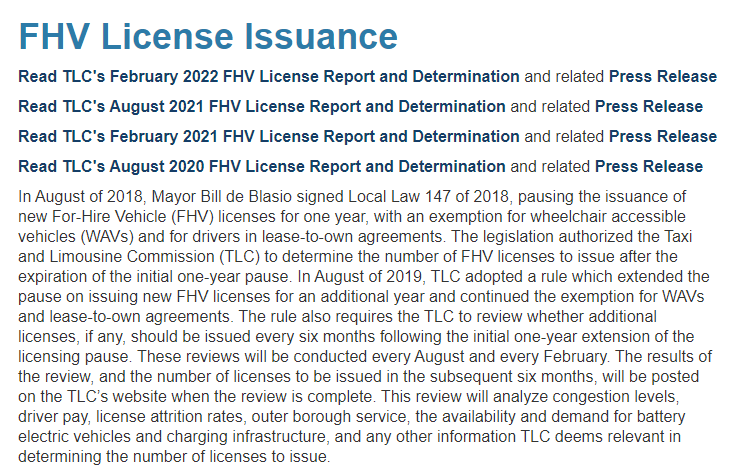🔐 TLC Plate Cap (Part 2): Base Exemptions, "One Driver, One Plate" & Congestion Politics
With the biannual FHV license determination (aka TLC plate cap decision) due soon, the NYC TLC market likely needs to come to terms with the limited vehicle status quo
AutoMarketplace.com NYC covers the for-hire transportation industry and automotive news. Check out AutoMarketplace.com on YouTube ▶️
☝️ Part 1 Summary
🚕 ~6,400 Inactive Taxi Medallions: The NYC Taxi & Limousine Commission (TLC) will likely NOT allow new FHV licenses (aka lifting the ‘TLC Plate Cap’), until the yellow taxi medallion market recovers & stabilizes
🍎 City Guarantee & Medallion Valuation: The historic taxi medallion debt restructuring agreement included a City guarantee on restructured medallion debt. Allowing new FHV licenses would likely and immediately invite litigation, as medallion values would be significantly impacted
✌️ Part 2 Summary
⬛ Black Car & Livery Base Licenses: While the NYC Black Car & Livery Base industries have several valid points regarding ‘base-specific’ TLC plates, the underlying issue relates to competitive dynamics
🔐 FHV Licenses In Storage: The TLC will likely need to announce a final FHV license storage removal deadline to normalize FHV supply and make sure the system isn’t being abused (“TLC Plate Squatting”)
1️⃣ One Driver, One Plate: A “One TLC Driver, One TLC Plate” policy seeks to prevent potential abuse by FHV leasing companies, given vehicle supply caps. While abuse must be investigated and quantified, adopting the existing medallion lease cap regime is a better alternative. While options for long term TLC drivers should be analyzed, a badly implemented “One Driver, One Plate” policy would severely impact the taxi medallion market
🤔 Congestion Pricing Politics: Allowing more NYC FHVs would significantly weaken the TLC industry’s efforts related to seeking an exemption from soon to be implemented Manhattan congestion tolling

With the biannual FHV license determination (often referred to as the ‘TLC Plate Cap’ decision) due to be published soon (last year the TLC’s August assessment was published on September 10th), it’s probably worth wrapping up our two part series on the ‘TLC Plate Cap’ (see below for Part 1 👇).
⬛ Black Car & Livery Base Licenses
In early August, traditional (non-Uber and Lyft) NYC Black Car & Livery base owners gathered in front of City Hall asking to be exempted from the industry wide TLC Plate Cap. The main argument being that their businesses are suffering because they cannot find drivers (& cars) to service their clientele.
The NYC livery industry, often local community car services, frequently pick and drop off clients within the 5 boroughs who use a local base for several reasons. Some may prefer to pay in cash or are more comfortable speaking a native language (i.e., prefer a Spanish speaking driver). Livery base owners argue the cap on new FHV licenses has hampered their businesses because they can’t effectively find drivers (vehicles) for trip demand.
The NYC black car sector, which mostly consists of locally or regionally headquartered companies with corporate and private clientele, also argues they can’t effectively compete or win new contracts due to driver (vehicle) supply issues. Both livery and black car services have also made the point that they aren’t responsible for the vehicle congestion that triggered the TLC Plate Cap in the first place and are unfairly being punished for Uber & Lyft’s meteoric growth.
While some of these arguments make sense and are valid, they aren’t addressing the core underlying issue. Many black car & livery bases have failed to recruit NYC drivers because, bluntly, they have not been able to effectively compete with Uber & Lyft. Both from a trip demand and driver experience perspective. We know this firsthand. For example, one base unfairly let other “favored” drivers “skip the line” to pick up passengers in an airport queue when the drivers we work with, were patiently waiting their turn. This upset the drivers so much, they completely left working for the base (btw this is after that same base charged them ~$150 for a base dispatching tablet).
Remember, all bases, including Uber & Lyft, are competing for the same driver (vehicle) supply pool given NYC TLC drivers (vehicles) can work across companies (known as “cross base dispatching rights”). It also, in our view, seems very unlikely that the TLC grants a “base specific” FHV exemption, when these same bases already have two distinct advantages vs. Uber & Lyft.
NYC livery bases are exempt from 8.875% sales tax
NYC black car & livery bases are not subject to TLC minimum pay standards
We’ve personally met and know many hardworking black car & livery base owners. We know many won’t be happy with the assessment above, but sometimes telling someone the truth is better than pretending and watching them struggle.
We WANT Uber & Lyft to have competition, we WANT TLC drivers to have more options to choose from. We WANT vibrant and financially sustainable local NYC bases. However, many NYC black car and livery bases cannot attract drivers because Uber & Lyft are outcompeting them. In the minutiae there are other reasons for sure, but this is the underlying issue.
Finally, creating a “base specific” license can lead to other problems where a driver is unfairly beholden to a SINGLE base that controls a vehicle license. For example, what if a TLC driver wants to work for a competitor base, how does that dynamic look?
🔐 FHV Licenses in Storage
During the COVID pandemic, given the TLC Plate Cap (i.e., once a license is surrendered, it’s permanently retired), TLC drivers and fleets were allowed to put FHV licenses in storage. Remember, to keep an FHV license active one also still needs to pay expensive insurance premiums as well. No income with expensive insurance premiums was a recipe for financial disaster, so the TLC correctly took action.
Even with this option, during the pandemic period we calculate nearly 20,000 NYC FHV Licenses (TLC Plates) were PERMANENTLY retired (the figure appears to have stabilized now though). As the NYC for-hire transportation industry recovers, we think it’s time now to force FHV licenses (aka TLC plates) to either come out of storage or be permanently retired. We believe, a deadline to remove plates from storage should be communicated soon - perhaps by the end of this year or after the typical annual TLC insurance renewal cycle that will conclude at the end of February 2023. Our fear is certain drivers or fleets maybe “TLC Plate squatting”, artificially impacting natural demand and supply mechanisms that the industry needs to understand in making effective policy, including related to the FHV License Determination. Even with ~20,000 TLC plates retired, a long way is left for vehicle supply and demand dynamics to normalize, especially contextualizing taxi medallion industry goals.


1️⃣ One Driver, One Plate
With the decision to remove the electric vehicle (EV) exemption to the TLC Plate Cap in June 2021, the only way a NYC TLC driver, who doesn’t currently control their FHV license, can add a TLC-plated car is by buying a wheelchair accessible vehicle (WAV).
As we’ve written previously, this has caused concern among some TLC drivers and driver advocacy groups, such as the Independent Drivers Guild (IDG). In fact, the IDG has an active campaign and petition related to the issue (‘Drivers Deserve the Right to Own Their Own Vehicles’).
The IDG BELIEVES that the TLC Plate Cap has left thousands of drivers at the mercy of exploitative fleet companies, some that control thousands of for-hire vehicle licenses. We believe the IDG has some conceptually valid points (i.e., we previously argued that lease caps, similar to the medallion market, should be considered), but it needs to specifically point out and quantify where abuses are occurring.
The IDG also fundamentally mischaracterizes a few dynamics which impacts their ability to effectively argue their case.
The Cost of a TLC Rental: “$20,000 per year” includes the cost of the car, insurance, maintenance, etc., not just the car). While leasing rates can be cheaper, we would say it’s far from predatory given insurance costs, risks and the inflationary environment related to the automotive sector from vehicle acquisition to parts. We do agree though that leasing rates need to be tracked and subject to regulatory oversight.
Number of TLC Drivers Who Rent: Through an analysis of NYC Open Data, we estimated over 70% of current drivers own and operate their own vehicle. 30% of ~95,000 vehicles is still a big number, but not as dominant as implied.
Finally, as mentioned in Part 1, many also miss out on one very fundamental dynamic that makes ‘One Driver, One Plate’ tricky, which is totally unrelated to large leasing companies. The current state of the yellow cab industry and the City’s effective obligation, via a City loan guarantee on restructured medallion debt, to stabilize the taxi medallion market.
All that being said, the IDG is, at a high level, making a good point. A few fleet companies own thousands of licenses/cars and therefore over time could accrue a medallion-like power on drivers (i.e., exploitative leasing rates). In addition, we believe there should be a pathway for full-time TLC drivers, who’ve clearly shown a commitment to the industry, to control their own FHV license in some way or perhaps help them finance the purchase of a taxi medallion (which would help that market out immensely!).
As previously stated in several of our articles, certain shareholders of AutoMarketplace.com also operate a small FHV corporation focused on luxury vehicle rentals (BMWs, Mercedes, Cadillacs). If FHV corporation lease caps are introduced, which we are not against, policymakers must be careful to base calculations, among many other factors, on the type of vehicle being leased or risk destroying the luxury leasing industry. In other words the lease cap applied to a Toyota Camry, surely must be different than the one applied to a BMW.
The last point we’ll make on this topic is a financially viable leasing industry is needed in the NYC for-hire transportation industry. From TLC drivers lacking credit access to real working capital issues (i.e., TLC driver can’t afford cost of major auto repair creating vicious income / expense cycle), the TLC and drivers should understand that many parts of the leasing industry provide value to drivers. Bad actors should be called out 💯, but many fleet owners are simply small to medium sized businesses, involved in a capital intensive industry, that’s very regulated, filled with what many traditional financial institutions would classify as “bad credit risk” and make single to low teen digit profit margins (if that!).
🤔 Congestion Pricing Politics
The connection between NYC congestion tolling and the TLC allowing additional FHV licenses on City roads…should be fairly clear. If the TLC were to open up plates at this moment, it would significantly weaken the entire industry’s arguments around congestion tolling exemptions. Alternatively, a reminder to the MTA that NYC taxi & FHV supply is strictly regulated, will boost arguments for both classes of vehicles to be exempt from any sort of double taxation.
Concluding Thoughts
There’s a lot of data, qualitative dynamics & politics that influence the TLC’s biannual FHV License Determination. As we’ve outlined in Part 1 and above, we think, from taxi medallion market dynamics to congestion tolling, the TLC will determine that it is in the industry’s best interest to not issue additional FHV licenses. The TLC should release its report and determination within the next weeks.
As always, let us know your thoughts in the comments section below or by emailing us at info@automarketplace.com.
AutoMarketplace.com NYC covers the for-hire transportation industry and automotive news. Check out AutoMaplace.com on YouTube ▶️







Tlc plates should be given to full time drivers who are renting from these fleet owners paying 20k annually very unfair!
One should be given the choice to have their own plate or rent. Poor drivers should not be left at the mercy of fleet owners